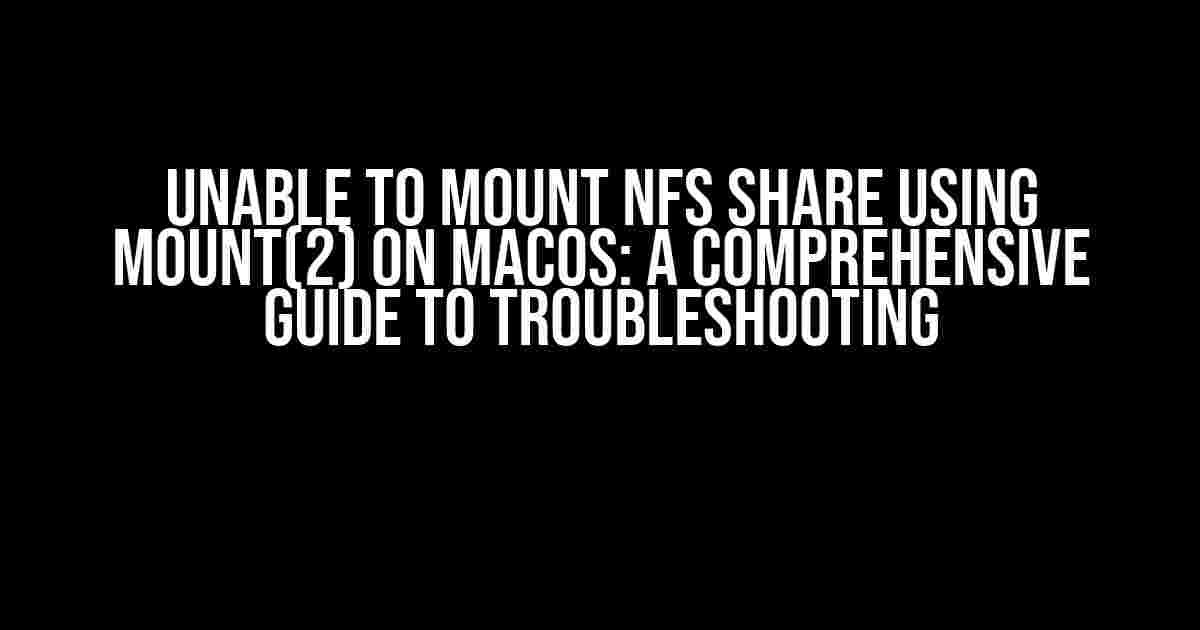Are you tired of banging your head against the wall trying to mount an NFS share on your macOS machine using the trusty old mount(2) command? You’re not alone! In this article, we’ll take a deep dive into the common pitfalls and provide clear, step-by-step instructions to get you back on track.
The Problem: Unable to Mount NFS Share on macOS
Before we dive into the solutions, let’s understand the problem. When you try to mount an NFS share using mount(2) on macOS, you might encounter errors like:
mount_nfs: can't mount /mnt from nfs-server-ip:/share onto /mnt: Operation not permitted
or
mount: /mnt: unknown special file or file system
Frustrating, right? Don’t worry, we’re about to tackle this issue head-on!
Prerequisites and Assumptions
Before we begin, make sure you have:
- A macOS machine with a compatible version (Mojave or later)
- An NFS server with a shared directory (we’ll call it
/share) - The NFS server’s IP address (we’ll call it
nfs-server-ip) - A local directory on your macOS machine to mount the NFS share (we’ll call it
/mnt)
Assuming you’ve met these prerequisites, let’s move on to the troubleshooting steps!
Troubleshooting Steps
Step 1: Verify NFS Server Configuration
First things first, let’s make sure the NFS server is configured correctly:
- Check the NFS server’s
/etc/exportsfile to ensure the share is exported correctly:
cat /etc/exports
Look for a line similar to:
/share 192.168.1.0/24(ro,async,no_subtree_check)
This line exports the /share directory to the 192.168.1.0/24 subnet with read-only access.
sudo showmount -e nfs-server-ip
This command should display the exported shares.
Step 2: Check macOS NFS Client Configuration
Now, let’s focus on the macOS NFS client configuration:
- Verify that the NFS client is enabled on your macOS machine:
sudo nfsd enable
This command enables the NFS client.
/etc/nfs.conf file to ensure it’s configured correctly:cat /etc/nfs.conf
Look for the following lines:
nfs.server.mount.require_resv_port = 0 nfs.client.mount.options = rw,async,noatime,vers=3
These lines configure the NFS client to use version 3 and allow mounting with the specified options.
Step 3: Mount the NFS Share Using mount(2)
Now that we’ve verified the NFS server and client configurations, let’s try mounting the share using mount(2):
sudo mount -t nfs -o rw,async,noatime nfs-server-ip:/share /mnt
This command mounts the /share directory from the NFS server to the local /mnt directory with read-write access, async I/O, and no access time updates.
If you still encounter issues, try adding the -v flag to enable verbose mode:
sudo mount -v -t nfs -o rw,async,noatime nfs-server-ip:/share /mnt
Step 4: Troubleshoot Common Issues
If you’ve reached this step and still can’t mount the NFS share, let’s troubleshoot some common issues:
| Error Message | Solution |
|---|---|
| mount_nfs: can’t mount /mnt from nfs-server-ip:/share onto /mnt: Operation not permitted | Ensure the NFS server’s IP address is allowed in the macOS machine’s firewall or add a rule to allow NFS traffic. |
| mount: /mnt: unknown special file or file system | Verify the NFS share is exported correctly on the NFS server and try remounting with the -v flag. |
| NFS server not responding | Check the NFS server’s status, ensure it’s running, and try pinging the NFS server’s IP address. |
Conclusion
By following these steps and troubleshooting common issues, you should be able to mount an NFS share using mount(2) on your macOS machine. Remember to verify the NFS server and client configurations, and don’t hesitate to add the -v flag for verbose mode.
If you’re still struggling, feel free to leave a comment below, and we’ll do our best to help you out!
Additional Resources
For further reading and troubleshooting, check out the following resources:
Happy troubleshooting, and may the NFS forces be with you!
Frequently Asked Question
Stuck with mounting NFS shares on macOS? Don’t worry, we’ve got you covered! Here are some common questions and answers to help you troubleshoot the issue.
Q1: What are the common reasons for unable to mount NFS share on macOS?
A1: The most common reasons for unable to mount NFS share on macOS include incorrect NFS server or share name, invalid mount options, insufficient permissions, firewall restrictions, and outdated NFS client software. Check these potential causes first before digging deeper!
Q2: How do I enable NFSv3 on my macOS to mount an NFS share?
A2: To enable NFSv3 on macOS, you need to add the `–vers=3` option to your mount command. For example: `sudo mount -o vers=3,proto=tcp,timeo=10 nfs-server:/share /mount/point`. Make sure to replace `nfs-server` with your actual NFS server name and `share` with the share name you want to mount.
Q3: Why do I get a “Permission denied” error when trying to mount an NFS share on macOS?
A3: The “Permission denied” error usually occurs when the macOS user doesn’t have sufficient permissions to mount the NFS share. Try using the `sudo` command to mount the share as an administrator, or add the `nobrl` option to your mount command to disable root squash. For example: `sudo mount -o nobrl nfs-server:/share /mount/point`.
Q4: How do I troubleshoot NFS mount issues on macOS using the mount command?
A4: To troubleshoot NFS mount issues on macOS, use the `mount -v` option to enable verbose mode. This will display detailed information about the mount process, helping you identify the exact error or issue. For example: `sudo mount -v -o vers=3,proto=tcp,timeo=10 nfs-server:/share /mount/point`.
Q5: Are there any third-party tools or software available to help mount NFS shares on macOS?
A5: Yes, there are several third-party tools and software available to help mount NFS shares on macOS. Some popular options include NFS Manager, Mount NFS, and AFP Connect. These tools provide a graphical user interface to simplify the mounting process and often include additional features like automatic mounting and connection management.
